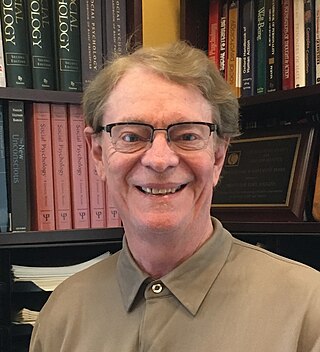In social psychology, an interpersonal relation describes a social association, connection, or affiliation between two or more persons. It overlaps significantly with the concept of social relations, which are the fundamental unit of analysis within the social sciences. Relations vary in degrees of intimacy, self-disclosure, duration, reciprocity, and power distribution. The main themes or trends of the interpersonal relations are: family, kinship, friendship, love, marriage, business, employment, clubs, neighborhoods, ethical values, support and solidarity. Interpersonal relations may be regulated by law, custom, or mutual agreement, and form the basis of social groups and societies. They appear when people communicate or act with each other within specific social contexts, and they thrive on equitable and reciprocal compromises.

Elliot Aronson is an American psychologist who has carried out experiments on the theory of cognitive dissonance and invented the Jigsaw Classroom, a cooperative teaching technique that facilitates learning while reducing interethnic hostility and prejudice. In his 1972 social psychology textbook, The Social Animal, he stated Aronson's First Law: "People who do crazy things are not necessarily crazy", thus asserting the importance of situational factors in bizarre behavior. He is the only person in the 120-year history of the American Psychological Association to have won all three of its major awards: for writing, for teaching, and for research. In 2007, he received the William James Award for Lifetime Achievement from the Association for Psychological Science, in which he was cited as the scientist who "fundamentally changed the way we look at everyday life". A Review of General Psychology survey, published in 2002, ranked Aronson as the 78th most cited psychologist of the 20th century. He officially retired in 1994 but continues to teach and write.
Equity theory focuses on determining whether the distribution of resources is fair. Equity is measured by comparing the ratio of contributions and benefits for each person. Considered one of the justice theories, equity theory was first developed in the 1960s by J. Stacey Adams, a workplace and behavioral psychologist, who asserted that employees seek to maintain equity between the inputs that they bring to a job and the outcomes that they receive from it against the perceived inputs and outcomes of others. According to Equity Theory, in order to maximize individuals' rewards, we tend to create systems where resources can be fairly divided amongst members of a group. Inequalities in relationships will cause those within it to be unhappy to a degree proportional to the amount of inequality. The belief is that people value fair treatment which causes them to be motivated to keep the fairness maintained within the relationships of their co-workers and the organization. The structure of equity in the workplace is based on the ratio of inputs to outcomes. Inputs are the contributions made by the employee for the organization.
The matching hypothesis argues that people are more likely to form and succeed in a committed relationship with someone who is equally socially desirable, typically in the form of physical attraction. The hypothesis is derived from the discipline of social psychology and was first proposed by American social psychologist Elaine Hatfield and her colleagues in 1966.
Interpersonal attraction, as a part of social psychology, is the study of the attraction between people which leads to the development of platonic or romantic relationships. It is distinct from perceptions such as physical attractiveness, and involves views of what is and what is not considered beautiful or attractive.
Fritz Heider was an Austrian psychologist whose work was related to the Gestalt school. In 1958 he published The Psychology of Interpersonal Relations, which expanded upon his creations of balance theory and attribution theory. This book presents a wide-range analysis of the conceptual framework and the psychological processes that influence human social perception. It had taken 15 years to complete; before it was completed it had already circulated through a small group of social psychologists.
Harold Kelley was an American social psychologist and professor of psychology at the University of California, Los Angeles. His major contributions have been the development of interdependence theory, the early work of attribution theory, and a lifelong interest in understanding close relationships processes. A Review of General Psychology survey, published in 2002, ranked Kelley as the 43rd most cited psychologist of the 20th century.
Martha Kent McClintock is an American psychologist best known for her research on human pheromones and her theory of menstrual synchrony.

Mahzarin Rustum Banaji FBA is an American psychologist of Indian origin at Harvard University, known for her work popularizing the concept of implicit bias in regard to race, gender, sexual orientation, and other factors.
Susan Tufts Fiske is an American psychologist who serves as the Eugene Higgins Professor of Psychology and Public Affairs in the Department of Psychology at Princeton University. She is a social psychologist known for her work on social cognition, stereotypes, and prejudice. Fiske leads the Intergroup Relations, Social Cognition, and Social Neuroscience Lab at Princeton University. Her theoretical contributions include the development of the stereotype content model, ambivalent sexism theory, power as control theory, and the continuum model of impression formation.

Edward Tory Higgins is the Stanley Schachter Professor of Psychology and Business, and Director of the Motivation Science Center at Columbia University. Higgins' research areas include motivation and cognition, judgment and decision-making, and social cognition. Most of his works focus on priming, self-discrepancy theory, and regulatory focus theory. He is also the author of Beyond Pleasure and Pain: How Motivation Works, and Focus: Use Different Ways of Seeing the World for Success and Influence.

David Shakow (1901–1981) was an American psychologist. He is perhaps best known for his development of the Scientist-Practitioner Model of graduate training for clinical psychologists, adopted by the American Psychological Association in 1949.
Sheldon Cohen is the Robert E. Doherty University Professor of Psychology at Carnegie Mellon University. He is the director of the Laboratory for the Study of Stress, Immunity and Disease. He is a member of the Department of Psychology at Carnegie Mellon and adjunct professor of Psychiatry and of Pathology at the University of Pittsburgh School of Medicine.
Harry Reis is a professor of psychology at the University of Rochester. He has been a leading figure in the field of social psychology, credited with helping to launch the study of relationship science and notable for his contribution to theories of intimacy. His research encompasses emotional regulation, the factors that influence social interaction, and consequences of different socializing patterns for health and psychological well-being.
Elaine Hatfield is an American social psychologist. She has been credited, alongside Ellen S. Berscheid, as the pioneer of the scientific study of love. She is employed as a professor in the psychology department of the University of Hawaii.
Sandra L. Murray is Professor of Psychology at the University at Buffalo, State University of New York. She is a social psychologist known for her work on close relationships and their trajectories over time. Murray received the American Psychological Association Award for Distinguished Scientific Early Career Contributions to Psychology in 2003 for "distinguished and original contributions to an understanding of motivated social cognition in relationships." Other awards include the New Contribution Award from the International Society for the Study of Personal Relationships in 1998 and 2000, the Outstanding Early Career Award from the International Society for Self and Identity in 2000, the Career Trajectory Award from the Society of Experimental Social Psychology in 2012, the Mid-Career Distinguished Contribution Award from the International Association for Relationship Research in 2016, and the SUNY Chancellor's Award for Excellence in Scholarship and Creative Activities in 2020.

David H. Barlow is an American psychologist and Professor Emeritus of Psychology and Psychiatry at Boston University. He is board certified by the American Board of Professional Psychology. Barlow is known for his research and publications on the etiology, nature, and treatment of anxiety disorders. The models and treatment methods that he developed for anxiety and related disorders are widely used in clinical training and practice. Barlow is one of the most frequently cited psychologists in the world.
Relationship science is an interdisciplinary field dedicated to the scientific study of interpersonal relationship processes. Due to its interdisciplinary nature, relationship science is made-up of researchers of various professional backgrounds within psychology and outside of psychology, but most researchers who identify with the field are psychologists by training. Additionally, the field's emphasis has historically been close and intimate relationships, which includes predominantly dating and married couples, parent-child relationships, and friendships & social networks, but some also study less salient social relationships such as colleagues and acquaintances.
In psychology, a distinction is often made between two types of love. Elaine Hatfield & G. William Walster define them as:




